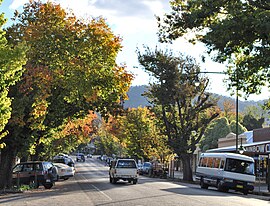Yackandandah
| Yackandandah Victoria | |
|---|---|
 High Street, recorded on the Register of the National Estate | |
 Yackandandah | |
| Coordinates | 36°18′47″S 146°50′21″E / 36.31306°S 146.83917°ECoordinates: 36°18′47″S 146°50′21″E / 36.31306°S 146.83917°E |
| Population | 950 (2011 census)[1] |
| Postcode(s) | 3749 |
| Location |
|
| LGA(s) | Shire of Indigo |
| State electorate(s) | Benambra |
| Federal division(s) | Indi |
Yackandandah /ˈjækənˌdændə/ is a small tourist town in northeast Victoria, Australia. It is near the regional cities of Wodonga and Albury, and is close to the tourist town of Beechworth. At the 2011 census, Yackandandah had a population of 950.[1]
History[]
It is a former gold mining centre known for its alluvial wet mining techniques. Yackandandah Post Office opened on 13 June 1856. Another office nearby, Yackandandah Junction, opened in 1872 but closed in 1885.[2]
In his local book, Antony O'Brien (p. 22) quotes an old poem published in the Melbourne Punch, 11 June 1857, titled, "The Lass of Yackandandah".
Let poets sing of English girls,
Their beauty and their candor;
Give me a sweeter nymph than all, –
The lass of Yackandandah."
"She draws a cork with such an air,
No mortal can withstand her;
She turns a tap, and turns our heads, –
The lass of Yackandandah.— O'Brien, The Lass of Yackandandah – a goldfield beauty
Today[]
The area is now predominantly a dairy farming and forestry region and has numerous bed and breakfast lodges which allow its many visitors to enjoy the peace and tranquillity of the district's forest and mountains.
The town is affectionately known as "Yack".
The commercial center of the town, known as the Yackandandah Conservation Area, is recorded on the Register of the National Estate.[3]
Sports & Recreation[]
The town has had an active Australian rules football team since its first club meeting in 1881[4] and have competed in the Tallangatta & District Football League, since 1945, winning senior football premierships in 1964 and 2000.
Golfers play at the course of the Yackandandah Golf Club on Racecourse Road.[5]
The Yackandandah Cricket Club play in both junior and senior grades in the Cricket Albury Wodonga competition.
Rail[]
The Yackandandah railway line once linked Yackandandah to Beechworth and opened in 1891.[6] The route to Woorragee and from there to Yackandandah was steep; trains descending the last gradient into Yackandandah would halt (near the now Yackandandah turnoff, from the Beechworth-Wodonga Road) so the guard could apply hand-brakes to carriages and wagons. The last train on the Yackandandah-Beechworth line was in July 1954.[7] Though the line was torn up, many sections of the original right of way are visible from the roadway between Beechworth and Yackandandah. In May 2017 the Victoria State Government budgeted for an extension of the Murray to Mountains Rail Trail side branch from Beechworth to Yackandandah.[8] The side branch currently extends from Beechworth to Everton Station, where it connects to the main trail.
Culture[]
Used for the filming of the 2003 film Strange Bedfellows (starring Michael Caton and Paul Hogan). Yackandandah is home to the annual Yackandandah Folk Festival attracting local, Australian and international artists since 1998.[9] Like the larger neighboring town of Beechworth, Yackandandah promotes itself as a tourist destination on the basis of its gold mining history and features a period streetscape as well as an increasing number of antique shops.
Two historic buildings, the 146-year-old museum (formerly the Bank of Victoria) and an adjacent timber store ("Rainbow Crystal"), were destroyed by a fire in the early morning of 21 December 2006. A real estate agency was also severely damaged.[10] The museum was rebuilt, reopening in November 2008.[11]
Further reading[]
- O'Brien, Antony. Shenanigans on the Ovens goldfields: The 1859 election, Artillery Publishing, Hartwell, 2005.
- Larsen, Wal. The Mayday Hills Railway, Wal Larsen, Bright, 1976.
References[]
- ^ a b Australian Bureau of Statistics (31 October 2012). "2011 Community Profiles: Yackandandah". 2011 Census of Population and Housing [1]
- ^ Phoenix Auctions History, Post Office List, retrieved 23 March 2021
- ^ "Yackandandah Conservation Area, Yackandandah, VIC, Australia (Place ID 4677)". Australian Heritage Database. Department of the Environment. Retrieved 12 March 2013.
- ^ "1881 - Yackandandah". Ovens and Murray Advertiser (Beechworth, Vic). 21 May 1881. p. 1. Retrieved 10 September 2021.
- ^ Golf Select, Yackandandah, retrieved 11 May 2009
- ^ Eardley, Gifford. — "The Ovens Valley Goldfields Railways". — Australian Railway Historical Society Bulletin. — December 1968. — pp.281-294.; January 1969. - pp.1-18.
- ^ Larsen, Mayday Hills
- ^ "Media release: Multi-million dollar tourism & jobs package". Indigo Shire Council. Archived from the original on 19 June 2017. Retrieved 19 September 2020.
- ^ "Yackandandah Folk Festival". yackfolkfestival.com/. Retrieved 4 July 2021.
- ^ Switzer, Renee (21 December 2006). "Historic buildings razed in blaze". The Age. Retrieved 12 March 2012.
- ^ "Yackandandah's tribute to history". Weekly Times. 1 February 2012. Retrieved 12 March 2013.
External links[]
![]() Media related to Yackandandah at Wikimedia Commons
Media related to Yackandandah at Wikimedia Commons
- http://www.exploreyackandandah.com.au — The Official Yackandandah Tourism (Indigo Shire) Web Site
- Yackandandah Folk Festival home page.
- yackandandah.com
- Towns in Victoria (Australia)
- Towns in Upper Hume
- Shire of Indigo
- Mining towns in Victoria (Australia)
